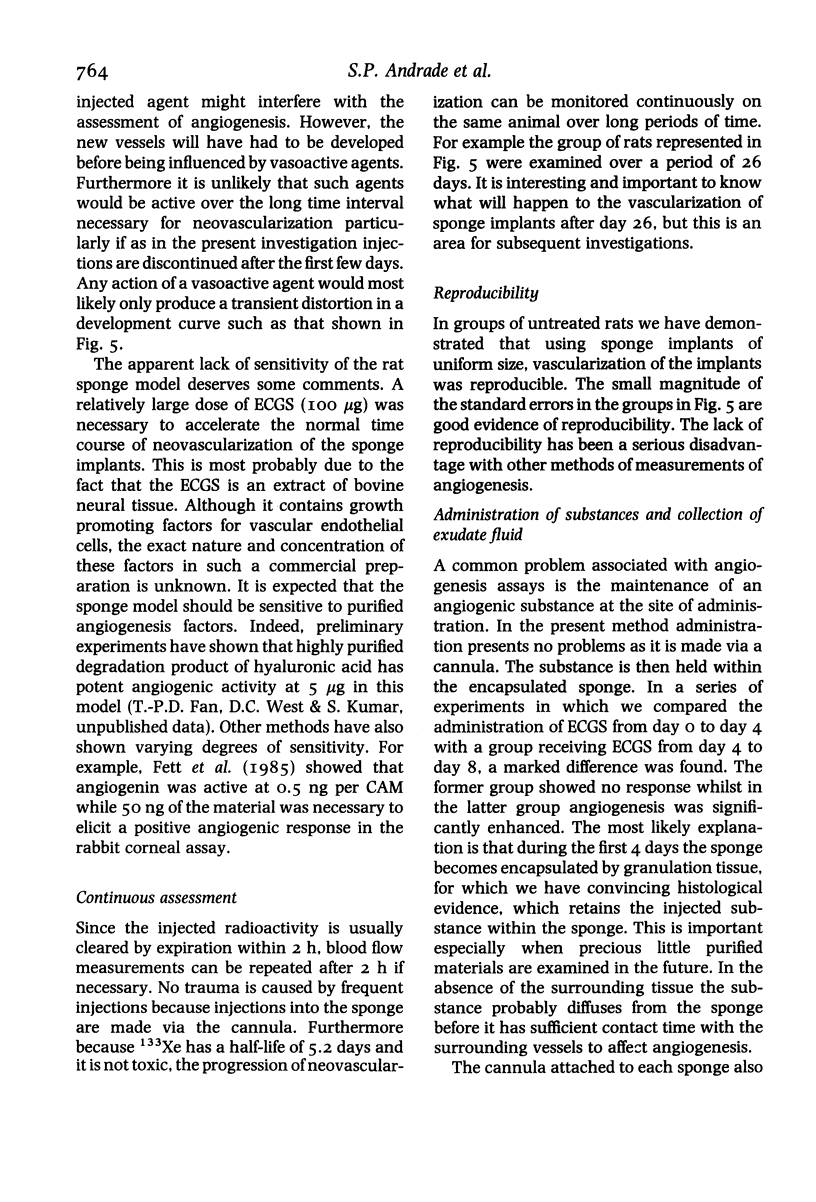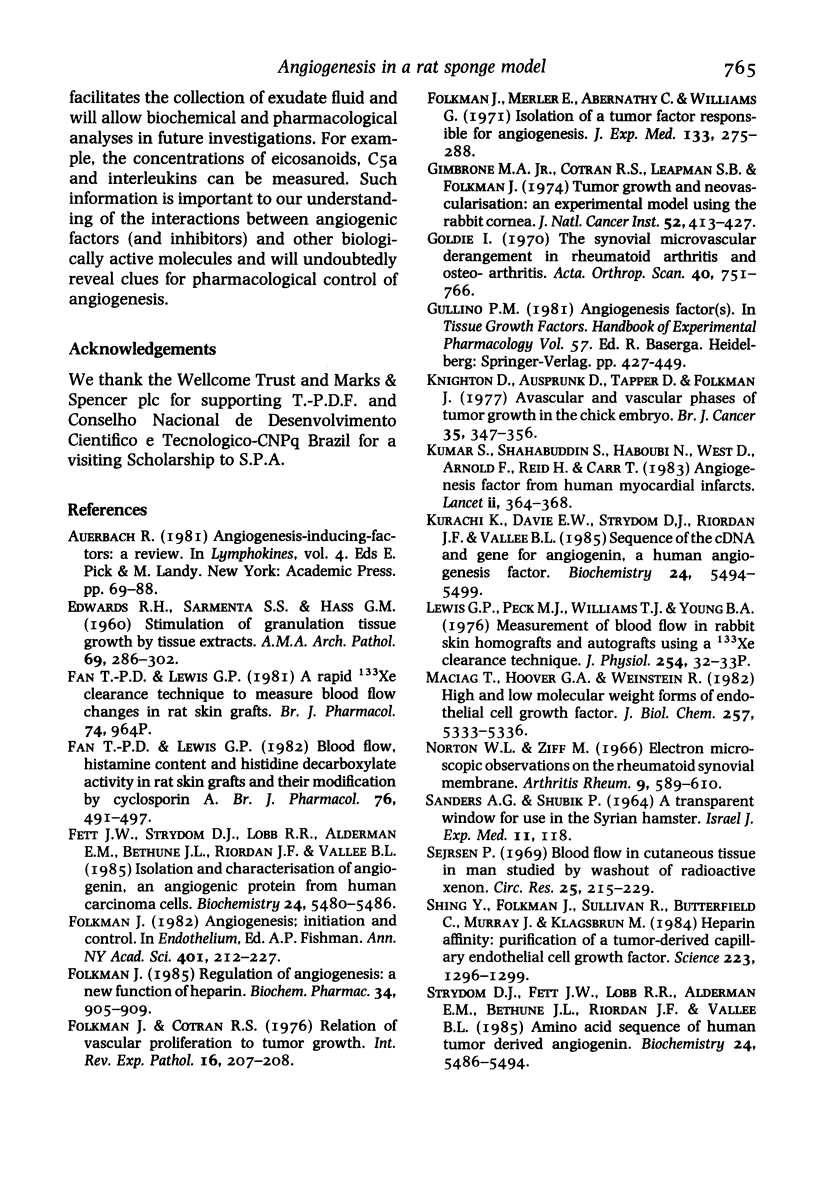Abstract
A method for quantitative in-vivo studies on angiogenesis is described in this article. It is based on subcutaneous implantation of sterile polyester sponges in the rat and subsequent measurement of blood flow in the implants as they become vascularized. The blood flow in an implant was measured in terms of per cent 133Xe-saline clearance 6 min after the radio-isotope was injected into the sponge via a cannula attached to it. Since originally the sponge contained no blood vessels, the development of blood flow would represent a neovascularization. Histological examination of implants removed at fixed time intervals confirmed that the sponges were initially encapsulated by granulation tissue and gradually infiltrated by host blood vessels. Under standard conditions, the 133Xe clearance from sponges 16 days post-implantation approached the clearance obtained in normal skin. The new blood vessels in the sponges were reactive to vasodilator prostaglandin-E2 and vasoconstrictor noradrenaline applied topically. Furthermore, we have shown that local administration of endothelial cell growth supplement accelerated angiogenesis while protamine delayed its onset. Thus the model offers a new means for objective, continuous and reproducible studies on the controlling mechanisms of angiogenesis.
Full text
PDF











Images in this article
Selected References
These references are in PubMed. This may not be the complete list of references from this article.
- EDWARDS R. H., SARMENTA S. S., HASS G. M. Stimulation of granulation tissue growth by tissue extracts. Study in intramuscular wounds in rabbits. Arch Pathol. 1960 Mar;69:286–302. [PubMed] [Google Scholar]
- Fan T. P., Lewis G. P. Blood flow, histamine content and histidine decarboxylase activity in rat skin grafts and their modification by cyclosporin-A. Br J Pharmacol. 1982 Jul;76(3):491–497. doi: 10.1111/j.1476-5381.1982.tb09244.x. [DOI] [PMC free article] [PubMed] [Google Scholar]
- Folkman J. Angiogenesis: initiation and control. Ann N Y Acad Sci. 1982;401:212–227. doi: 10.1111/j.1749-6632.1982.tb25720.x. [DOI] [PubMed] [Google Scholar]
- Folkman J., Cotran R. Relation of vascular proliferation to tumor growth. Int Rev Exp Pathol. 1976;16:207–248. [PubMed] [Google Scholar]
- Folkman J., Merler E., Abernathy C., Williams G. Isolation of a tumor factor responsible for angiogenesis. J Exp Med. 1971 Feb 1;133(2):275–288. doi: 10.1084/jem.133.2.275. [DOI] [PMC free article] [PubMed] [Google Scholar]
- Folkman J. Regulation of angiogenesis: a new function of heparin. Biochem Pharmacol. 1985 Apr 1;34(7):905–909. doi: 10.1016/0006-2952(85)90588-x. [DOI] [PubMed] [Google Scholar]
- Knighton D., Ausprunk D., Tapper D., Folkman J. Avascular and vascular phases of tumour growth in the chick embryo. Br J Cancer. 1977 Mar;35(3):347–356. doi: 10.1038/bjc.1977.49. [DOI] [PMC free article] [PubMed] [Google Scholar]
- Maciag T., Hoover G. A., Weinstein R. High and low molecular weight forms of endothelial cell growth factor. J Biol Chem. 1982 May 25;257(10):5333–5336. [PubMed] [Google Scholar]
- Sejrsen P. Blood flow in cutaneous tissue in man studied by washout of radioactive xenon. Circ Res. 1969 Aug;25(2):215–229. doi: 10.1161/01.res.25.2.215. [DOI] [PubMed] [Google Scholar]
- Strydom D. J., Fett J. W., Lobb R. R., Alderman E. M., Bethune J. L., Riordan J. F., Vallee B. L. Amino acid sequence of human tumor derived angiogenin. Biochemistry. 1985 Sep 24;24(20):5486–5494. doi: 10.1021/bi00341a031. [DOI] [PubMed] [Google Scholar]
- Vu M. T., Smith C. F., Burger P. C., Klintworth G. K. An evaluation of methods to quantitate the chick chorioallantoic membrane assay in angiogenesis. Lab Invest. 1985 Oct;53(4):499–508. [PubMed] [Google Scholar]






